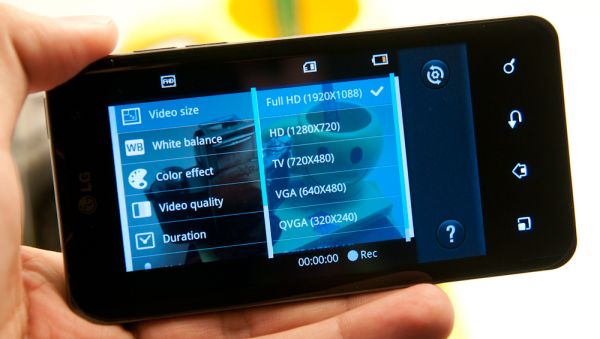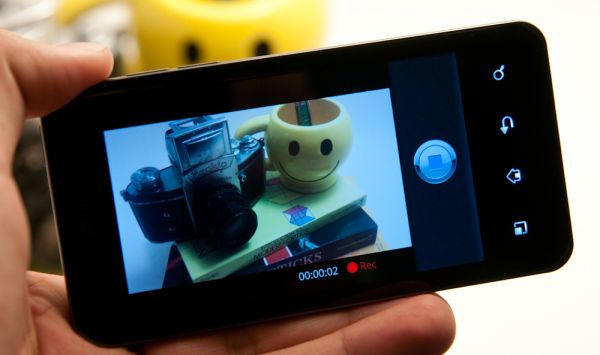LG Optimus 2X & NVIDIA Tegra 2 Review: The First Dual-Core Smartphone
by Brian Klug & Anand Lal Shimpi on February 7, 2011 3:53 AM EST- Posted in
- Smartphones
- Tegra 2
- LG
- Optimus 2X
- Mobile
- NVIDIA
Video Capture
The other big part of the 2X is that it’s the first smartphone to do H.264 1080P video capture. We took the 2X out to our usual test site and recorded video on the 2X at every quality setting at 1080p, and at maximum quality at 720P and VGA resolutions, and one final video with the front facing camera. I looked at the videos and then had Ganesh, our resident media center and video expert, as well as Anand take a look at the same original videos and compare to our other devices. It’s hard to argue that the iPhone 4 and Nokia N8 aren’t the devices to beat, both of them cranking out impressively sharp 720P video. We’ve done the usual thing and uploaded all the test videos to YouTube in addition to making a big zip for comparison in their original glory—links are in the table below.
Before we get to our comparison, a little background. First off, the 2X records 1920x1088 video in H.264 Baseline profile at an average of around 12 Mbps, audio is 1 channel AAC at 64 Kbps. The specifications for the 2x say 1080p24, in practice I’ve seen some framerate variability between 24 and 30 depending on lighting conditions. These videos are close to but not exactly 30 FPS, two videos I shot with the 2X at CES are clearly 24 FPS. Why the extra 8 pixels of vertical resolution, you might be wondering? The reason is simple—1088 is an even factor of 16, and macroblocks are 16x16 pixels.
| LG Optimus 2X Video Capture Samples | |||||
| Rear Facing 8 MP Camera |
1080P—SuperFine 1080P—Fine 1080P—Normal 720P—SuperFine 480P—SuperFine |
||||
| Front Facing 1.3 MP Camera | VGA—SuperFine | ||||
| LG Optimus 2X vs iPhone 4 at 720P | Mashup—YouTube, MP4 (zip), iPhone 720P (zip) | ||||
| LG Optimus 2X Original Videos | Original Videos (153.6 MB zip) | ||||
So how does 1080p24 video shot on the 2X compare to the iPhone 4 and Nokia N8? Unfortunately, not all that well. At 1080P there’s noticeable softness and loss of high spatial frequency detail. At about the 3 second mark in the first video I took (1080p at Super Fine) there’s also some noticeable glare from light flaring off of the glass surface between the camera’s last vertex and the plastic battery door. It’s that kind of stuff that’s a bit frustrating to still see going on with smartphones. The video has noticeable macro-blocking artifacts in the dark regions as well, which is disappointing. Though the Tegra 2 ISP is competent as shown by still image quality, clearly the video encode engine needs a bit more work. SuperFine as we already mentioned corresponds to around 12 Mbps, Fine corresponds to 8.5 Mbps, Normal quality seems to hover around 6 Mbps. You can fit a little over an hour of SuperFine quality 1080P video on the user-accessible 6 GB partition of the 2X’s 8 GB internal storage.
The obvious comparison really is at 720P, where we can directly compare the 2X’s video quality to the N8 and iPhone 4. I don’t have the N8 anymore, our comparison video is still what’s in bench. I do still have an iPhone 4, and captured a video taken at the exact same time as the 2X held carefully above the other phone. You can view both for yourself or compare with a mashup I put together showing both at the same time. The video I made showing both has a bit of downscaling and is at 30 FPS (so the 2X video occasionally looks like it’s dropping frames when it really isn’t), but still illustrates the differences.
Watching both at the same time, it’s readily apparent that the iPhone 4 does a noticeably better job with high frequency spatial detail, where the 2X seems to have softening. The 2X does do a better job with the dark areas of the intersection when panning back, but there’s still macroblocking visible. It’s obvious that there’s a combination of encoder and optics holding the 2X back from having dramatically higher quality video.












75 Comments
View All Comments
Exophase - Monday, February 7, 2011 - link
Thanks Anand.I'm surprised to hear that shot was from IMG, given that it was an IMG employee who made the comment originally about Tegra's 16-bit banding being evident on it, from the screenshot. Whoops. I do wonder what could be causing this, then.
Nonetheless, while that definitely makes my 16bit color claim invalid the depth buffer one should still hold. We might need to wait and see how much of a difference this actually makes, or rather how effective nVidia's 16-bit depth space is.
I'm glad to hear that you're as concerned about benchmarks on Android as I am. It's especially frustrating when I see people using them to try to indicate Atom being substantially better clock for clock than Cortex-A9.
Exophase - Monday, February 7, 2011 - link
Managed to miss this:"The test ramps from around 3k vertices to 15k vertices per frame, and 190k to 250k triangles per frame"
That line doesn't make any sense. How would you have hundreds of times more triangles than vertices? You must have meant something else.
sid1712 - Monday, February 7, 2011 - link
Great review as usual but i'm disappointed about the lack of details on the Sound Quality of the phone. A comparison of the sound quality (via headphone jack) alongside the iPhone 4 and the Galaxy S (with Voodoo kernel preferrably) would give a good idea about the SQ of the phone.ScentedKandle - Monday, February 7, 2011 - link
Related to this, the audio codec lists "lossless" but doesn't mention what format. Can the audio chip natively decode FLAC?teldar - Monday, February 7, 2011 - link
The order of buttons if the same as my droid x.Pjotr - Monday, February 7, 2011 - link
Does it really record 1920x1088? Does this unorthodox resolution play well on TVs, if you put it on a USB stick, for example?Brian Klug - Monday, February 7, 2011 - link
It plays back from the phone properly, and most of the playback software just does a crop. A ton of devices actually produce 1088 and don't make note of it, it should playback fine.-Brian
unmesh - Monday, February 7, 2011 - link
For active aka switching transistor power consumption, C*V^2*f (C is capacitance and f is frequency) is a better proxy than V^2/R.The conclusion that operating voltage has a huge effect remains the same.
Kevin098 - Monday, February 7, 2011 - link
Hey, can you make a video comparison between the iphone 4 retina display and Optimus 2x ?StormyParis - Monday, February 7, 2011 - link
Pages and pages of (apparently not very acurate, too) perf data, and not even one line on sound quality, which is one of my key buying points for a phone.No info on whether I'll be able to stream PC-resolution videos off my server to my bed over wifi.
Overall, not a very useful review. More like a dick size contest.